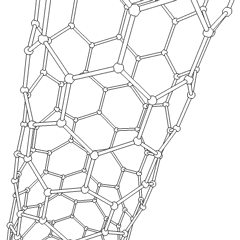 At Cenamps we are leading and managing the establisment of a national polymer electronic facility, PETeC, in the North East of England. The facility is to be built at NetPark in County Durham.
At Cenamps we are leading and managing the establisment of a national polymer electronic facility, PETeC, in the North East of England. The facility is to be built at NetPark in County Durham.
So its interesting for us to note that Jennifer Rocha reports in Nano World News ...."this month that a team of university researchers reported that organic single crystals can be patterned over a large area, paving the way for manufacturing of truly flexible electronics. “We have eliminated the handpicking process of fabricating single-crystal transistors," explains Alejandro Briseno, lead author of the study, and now a doctoral student at the University of Washington. Up to this point, organic transistors have not had the full performance or capacity of being mass-produced. The research team has not only developed a new technology of patterning single-crystal transistors, but has made the manufacturing of them possible--“in certain cases, we demonstrated that in as fast as 5 minutes in an area the size of a human fingernail," notes Briseno.
Mr. Briseno tells NWN, “We were motivated to investigate deeper into single-crystal transistors because their performance is much more superior than that of polycrsytalline films or polymers. But there was a major drawback; it was difficult to mass-produce transistors and very time-consuming as well. In addition, single-crystal transistors were mainly used for fundamental studies and for exploring basic charge-transport in single crystals. There was rarely any other application for them. So for the last couple of years Professor Bao [of Stanford University] and I have been committed in transforming single-crystal transistors to mainstream practical applications.” Briseno began his research collaboration with Dr. Bao several years ago, when she was at Bell Labs and he was an intern. The team for this research paper included researchers from UCLA (where Briseno received his master’s degree) and Stanford University (where Dr. Bao is a Professor). What are the potential applications of this novel technology and its use in flexible electronics? “The possible applications of our discovery include flexible electronics in general,” Briseno tells NWN. “But specifically, our transistors could enable low-cost sensors on product packaging and ‘electronic paper’ displays and even electronic rollable newspaper.” While it may be a while before the technology’s promise is fulfilled, Briseno believes discovery of patterned transistors promises a host of applications never before thought possible.” ..."
Shak Gohir
Labels: Displays, Nanotechnology, Polymer Electronics
 The Opensource Handbook of Nanoscience and Nanotechnology is a wikibook on nanoscience and nanotechnology gathers information about the various tools, methods and systems to provide students, researchers and everyone else an open-source handbook and overview guide to this vast interdisciplinary and expanding field - a book that can be adjusted as new things appear and improved by its readers.
The Opensource Handbook of Nanoscience and Nanotechnology is a wikibook on nanoscience and nanotechnology gathers information about the various tools, methods and systems to provide students, researchers and everyone else an open-source handbook and overview guide to this vast interdisciplinary and expanding field - a book that can be adjusted as new things appear and improved by its readers.



